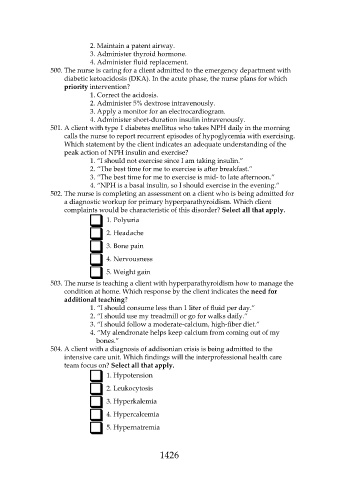Page 1426 - Saunders Comprehensive Review For NCLEX-RN
P. 1426
2. Maintain a patent airway.
3. Administer thyroid hormone.
4. Administer fluid replacement.
500. The nurse is caring for a client admitted to the emergency department with
diabetic ketoacidosis (DKA). In the acute phase, the nurse plans for which
priority intervention?
1. Correct the acidosis.
2. Administer 5% dextrose intravenously.
3. Apply a monitor for an electrocardiogram.
4. Administer short-duration insulin intravenously.
501. A client with type 1 diabetes mellitus who takes NPH daily in the morning
calls the nurse to report recurrent episodes of hypoglycemia with exercising.
Which statement by the client indicates an adequate understanding of the
peak action of NPH insulin and exercise?
1. “I should not exercise since I am taking insulin.”
2. “The best time for me to exercise is after breakfast.”
3. “The best time for me to exercise is mid- to late afternoon.”
4. “NPH is a basal insulin, so I should exercise in the evening.”
502. The nurse is completing an assessment on a client who is being admitted for
a diagnostic workup for primary hyperparathyroidism. Which client
complaints would be characteristic of this disorder? Select all that apply.
1. Polyuria
2. Headache
3. Bone pain
4. Nervousness
5. Weight gain
503. The nurse is teaching a client with hyperparathyroidism how to manage the
condition at home. Which response by the client indicates the need for
additional teaching?
1. “I should consume less than 1 liter of fluid per day.”
2. “I should use my treadmill or go for walks daily.”
3. “I should follow a moderate-calcium, high-fiber diet.”
4. “My alendronate helps keep calcium from coming out of my
bones.”
504. A client with a diagnosis of addisonian crisis is being admitted to the
intensive care unit. Which findings will the interprofessional health care
team focus on? Select all that apply.
1. Hypotension
2. Leukocytosis
3. Hyperkalemia
4. Hypercalcemia
5. Hypernatremia
1426

